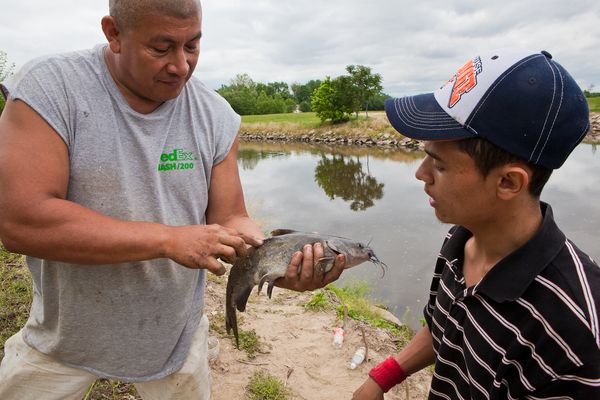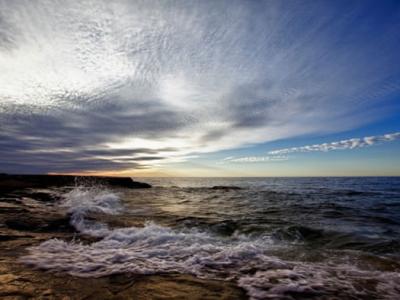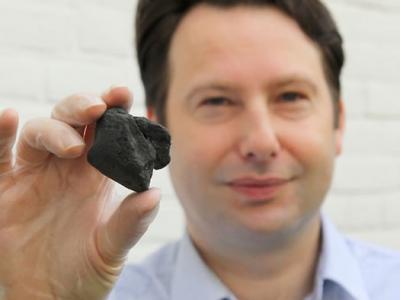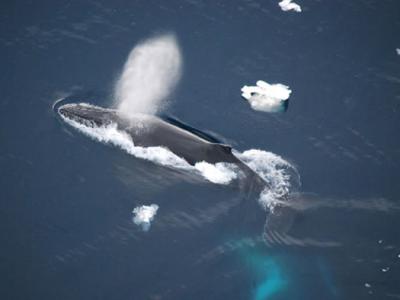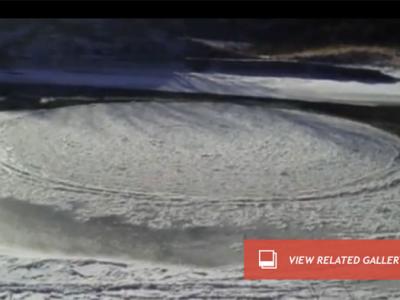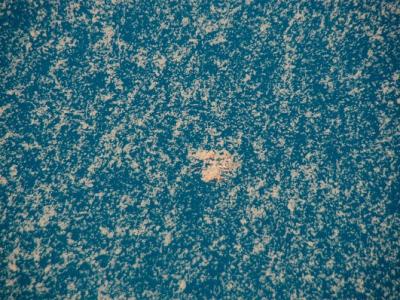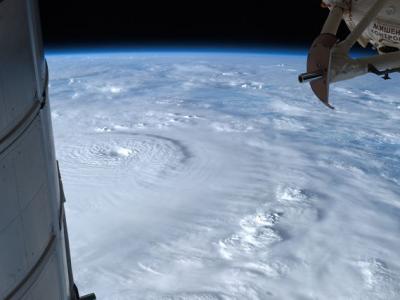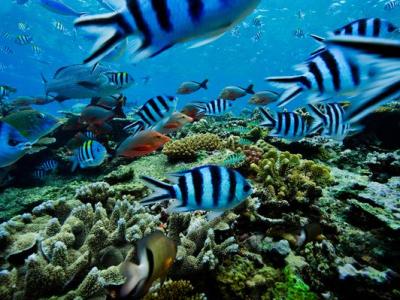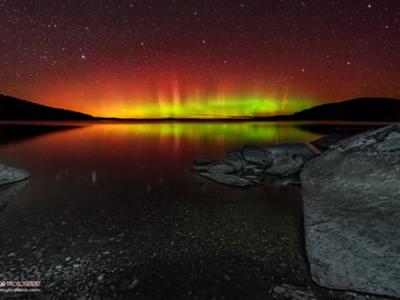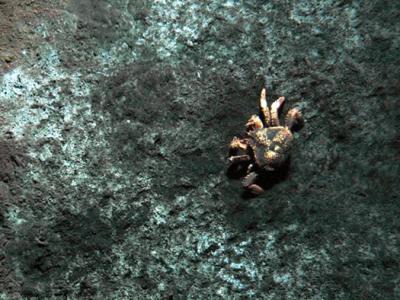Fishing the Forgotten River in the Nation’s Capital
Fermin Diaz shows Hilario Turcios a lesion on a blue catfish before throwing it back into the Anacostia River in Washington, D.C.
On a recent boat ride up the Anacostia River, the first warm day of spring had lured anglers to the riverbank. Cooped up over the winter, they seized the opportunity to return to their faithful friend—filled with catfish, perch and bass—to find some peace in nature and some dinner for the night.
But this was no Norman Rockwell painting. These fishermen were casting their lines into the urban waters of Washington, D.C., into a river notorious as one of the dirtiest in the nation. What's more, according to a recent study, they represented a small fraction of the 17,000 or more residents of this metropolitan area who are consuming fish from a river that has all the markings of a Superfund site.
Flanked by tackle boxes and coolers awaiting their catch, the fishermen sat on picnic benches and beach chairs alongside this murky river on its journey to the Potomac, recently named America's most endangered river. An overnight storm had dislodged garbage and petrochemicals from city streets and flushed them into the Anacostia. Plastic bottles, basketballs, and other detritus swam in an oily sheen that glistened upon the surface.
Just upstream from the multimillion-dollar Nationals Park, the anglers were book-ended by towering cranes, the beginning of a massive remediation project to remove three feet of toxic soil contaminants. And 30 feet upstream, built into the seawall constructed a century ago by the U.S. Army Corps of Engineers, was a combined sewer outflow. This archaic stormwater conveyance mechanism continues to dump a billion gallons of human waste and toxic runoff directly into the Anacostia every year.
Still, the fishermen sat contentedly under the cool shade of towering trees, hauling their catch from the water. In fact, more than contented, they seemed happy, at ease in a city that is known for frenetic tension. Perhaps it is the presence of turtles sunning themselves on logs at the edge of the river, or the constant chatter of birds hidden in the trees, or the nearby corridor of forest upstream that whispers the promise of solitude despite the centuries of abuse the river has weathered. There is something uniquely liberating about spending the day on a river catching your own dinner.
And all the more so when your other dining options might be fast food, getting in line at a food bank, or going hungry, as is the case for some in this economically disadvantaged watershed.
Just a few blocks west of the river, the reality of the Anacostia's fishing community is unknown. In the more affluent neighborhoods of the Washington, D.C., metro area, the idea that anyone would eat a fish caught in the Anacostia seems unthinkable. This society long ago accepted the assumption that the river was dead—and the dead are easily forgotten.
But not everyone has abandoned the Anacostia. As in so many places, those who have the least are often most closely tied to the land. In Washington, D.C., fish from this river have fed some of the city's African Americans for many generations—from the bonded Africans sold on the shores of the Chesapeake Bay to refugees of the Civil War South, to some of today's unemployed and poor residents east of the river. They are joined by recent immigrants, mostly Spanish-speakers who have continued their custom of fishing for dinner from the rivers of Central America.
Feeding the Hungry
River advocates and city officials once thought most of the fishing on the river was catch-and-release and that the number of people consuming fish from the river was minimal.
"We thought 25 to 50 individuals at most," said Mike Bolinder, the Anacostia Riverkeeper, whose title is the same as the nonprofit organization he represents.
But a recent study conducted by the Riverkeeper and a consortium of other nonprofits and government agencies found fish consumption to be much more prevalent. The study found that three-quarters of those fishing on the river are eating, or sharing, their catch. Though river and human health advocates and agencies do not have definitive studies linking cancers and other health problems to consumption of the river's fish, the animals themselves tell a worrisome tale. Studies of the Anacostia's bottom-feeding fish like the brown bullhead catfish have shown that between 50 and 68 percent have liver tumors, and almost a quarter have visible skin lesions.
The District of Columbia government has issued advisories, but to little effect, according to Bryan King, the city's associate director of fisheries and wildlife. The reasons, according to the fishing study, are tied to economics, but they are also rooted in language, culture, and even the primal forces of human dignity and generosity. For Spanish-speakers, conveying the risks of fish consumption is complicated—by language barriers, education levels, and immigration status, all of which can deter people from understanding advisories or even acquiring fishing licenses.
But even for those who have lived near the river for generations, the situation is complex. Some anglers have been fishing and eating out of the Anacostia for decades, and any warning from the government lacks credibility. "Surprise, surprise. We've been dumping toxic waste on them for 100 years. Why would they trust the government?" Bolinder said.
In many ways, history and memory have collided to build walls between the Anacostia community and the government and river advocates.
"Sixty-five percent of the anglers are black and 15 percent of this room is black," said King, at a recent meeting to discuss the results of the survey. "You can tell them not to eat the fish all day long; they're not going to believe you. You're fighting a lot of issues beyond fish toxicity here."
Some of those issues are nearly as old as the river itself—namely poverty and hunger. Even fishermen who don't eat the fish themselves, who understand there are health risks, will share the fish with others in need.
"If they have concerns about the health of the fish, it is being overcome by the gratification of helping others," said the survey conductor, Steve Raabe, president of Opinion Works. "They're thinking, 'Health risk? Okay, maybe. But this person's hungry and I'm going to help them right now.'"
This poses a predicament for those responsible for public outreach.
"How can you tell someone 'You might get cancer in ten years from this,' when they are hungry today?" asked Juliet Glassroth, a communications professional involved in the study.
Looking Ahead
Unfortunately, this sword has more than two edges for those responsible for river and community advocacy. Every negative headline for the river has the potential to energize supporters but also alienate visitors, and the Anacostia needs all the friends it can get.
It needs friends like Alphonzo Wright, and anglers like him, who embody the contentment that can be found on a riverbank.
"This is it!" Wright grinned widely on a sunny Saturday afternoon in May, holding a pole, waiting for a bite. Most spare moments he is found on a quiet stretch of the river hauling in fish—mostly catfish that he won't eat, but saves for a friend.
"I've been fishing since I was a kid, my whole family has," he said. "Fishing and bowling, that's what we all do."
People like Wright and the thousands of other anglers and kayakers who spend time on the river spark an added urgency for advocacy groups like the Riverkeeper, Anacostia Watershed Society, and others working to clean up the Anacostia. But restoring the river will take decades, even under the best of circumstances.
According to a 2011 study, "A New Day for the Anacostia," compiled by the nonprofit DC Appleseed, the outlook for Anacostia restoration depends largely on the willingness of the federal government to fully fund and lead clean-up of a river that it was largely responsible for despoiling.
Ultimately, this latest chapter in the river's history could be a turning point toward ecological salvation and environmental justice. Much depends on the ability of advocates to harness the chronicle of the Anacostia fishermen into an irrefutable call for action.
"Written right into the Clean Water Act is 'this river should be fishable and swimmable,' said Bolinder. "This is the clarion call to clean up the river so that we don't rob the community of their right to go catch fish, and bring it home and eat it."
Krista Schlyer
For National Geographic News
Published July 23, 2012
